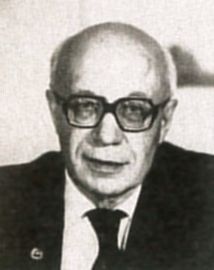


Obituary
Boris Konstantinovich Vainshtein (1921-1996)

Boris Vainshtein, Russian physicist and crystallographer, Dr. of Physics and Mathematics, full member of the Russian Acad. of Sciences, Director of the Shubnikov Inst. of Crystallography of the Russian Acad. of Sciences, and Chairman of the Russion Natl Committee for Crystallography, died suddenly at his home in Moscow on October 28, 1996, at the age of 75.
Vainshtein was born in Moscow in 1921. He graduated from Moscow State U. (Physical Dept) and from the Moscow Inst. of Steel and Alloys (Research Dept). In 1945, he joined the Inst. of Crystallography as a post-graduate student and remained there for the rest of his life. He received his Ph.D. in 1950 and D.Sc. degree in Physics and Mathematics in 1956. In 1959, he founded the Lab. of Biocrystal Structures, and in 1959, he became Director of the Institute. In 1976, he was elected to membership in the Academy of Sciences of the Soviet Union and was the head of the Scientific Council on Physics of Crystals.
Vainshtein was one of the cadre of Russian Scientists who developed 20th century Russian science as it is now. His early studies were devoted to electron diffraction. Vainshtein suggested an idea of Fourier synthesis of the lattice potential and deduced the general formulas for electron diffraction structure analysis. He was the first to reveal the positions of hydrogen atoms in crystal structures. Beginning in the late 50s, he took an interest in the structures of biological materials. With coworkers, he determined the structures of synthetic polypeptides and amino acids. He developed the theory of X-ray diffraction by polymers and liquid crystals, applied electron microscopy to the study of biocrystals, developed direct methods of reconstruction of structure, and used these methods to solve structures of proteins and bacteriophages. Vainshtein and his coworkers determined the structures of more than 20 antibiotics, proteins, and viruses. A number of the proteins (leghemoglobin, aspartate aminotransferase, ribonucleases, pyrophosphatase, various catalases, etc.) were determined at atomic resolution. Vainshtein's monographs Structure Analysis by Electron Diffraction (1964) and Diffraction of X-rays by Chain Molecules (1966) are well known classics. One of his latest works was the four-volume Modern Crystallography (1994), which he contributed to and edited. He received the Ewald prize, the highest international crystallographic award. He was a honorary member of the German Leopoldina Acad., the Polish Acad. of Sciences, the Barcelona Acad., the Roland Eotvos Physical Soc. (Hungary), and the Science Catalan Inst. He had honorary degrees from Stockholm U., U. of York, and U. of Keele.
Under Vainshtein's leadership, the Inst. of Crystallography became one of the world's leading research institutions in which almost all branches of modern crystallography flourished. Scientists trained at the Inst. now work in labs all over the world. In the summer of 1996, at a 75th anniversary celebration he delivered a superb lecture describing the Inst. and its accomplishments.
On his last working day he met with coworkers, resolved current problems, and made plans. A distinguished scientist, an intelligent and kindly man has died. He was a magnet attracting all the best in science. He gave fellow scientists every support and encouragement. In this troublesome time, his belief in a better future for science in Russia was a source of strength for all those around him. Vainshtein was fond of chess, skiing, poetry and fine arts. He will remain in our grateful memory forever. He is survived by his wife and their children, Olga and Alexander, and grandchildren.
Emil Harutyunyan and William Melik-Adamyan

